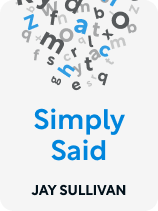

This article is an excerpt from the Shortform book guide to "Simply Said" by Jay Sullivan. Shortform has the world's best summaries and analyses of books you should be reading.
Like this article? Sign up for a free trial here .
Should you stand or sit when delivering a presentation? Is it better to move or stand still? What about eye contact?
Most communication is nonverbal, which also applies to public speaking. Your body language and your facial expressions communicate your confidence, your level of comfort, and your engagement. One rule of thumb to follow is to display openness and confidence with your body and make occasional eye contact with members of the audience.
Here are some presentation body language tips to keep in mind.
Body Language in Public Speaking
Your body language should be open and neutral, whether you choose to stand or sit:
Standing: Stand with your feet directly under your hips with your weight evenly distributed and your hands apart—this keeps you from fidgeting or crossing your arms, which makes you look closed off. It also leaves you free to use hand gestures to emphasize your points.
Seated at a table: Sit up straight and stay still (no swiveling), keeping your forearms on the table with your hands on either side of your notes.
Sullivan adds that your facial expression should convey that you want to be there; even if you’re delivering bad news and deem it inappropriate to smile, wear a sincere expression that shows you’re ready and willing to provide support.
| Online Presentation: Body Language and Facial Expressions Sullivan doesn’t discuss how to best use body language when delivering a presentation through a video call, but teleconferencing is becoming more and more common. To keep your audience engaged during your online presentation, experts recommend the following tips: – Maintain eye contact by focusing on your webcam. It helps to position your webcam on the same level as your eyes—prop up your laptop if needed. – Sit up straight. Sit on the edge of your chair to keep you from slouching and make you look more engaged. – Keep the upper half of your body visible on screen so that people can see your hand gestures. Even if they can’t see your hands, don’t stop yourself from making natural hand gestures—you’ll look more genuine that way. – Make your face the focus by being expressive. Smile and nod, and be sure that you’re actually seen. Keep your light source in front of you. – Minimize distractions by having a clutter-free background. |
Use Eye Contact to Connect With Your Audience
Every time you say something, make eye contact with members of the audience. However, Sullivan says your eyes shouldn’t constantly dart around the room. The proper way to make eye contact when presenting to a group is to look at one person for as long as it takes to complete a sentence. Then, move onto another person. Give key decision-makers more attention, but don’t ignore all the other people in the room—you want to make your whole audience feel like you’re connected to them.
(Shortform note: Making eye contact with your audience, as Sullivan recommends, not only forges a connection with them but also clues you in on how they’re receiving your message. In 12 Rules for Life, Jordan Peterson says you can use eye contact to gauge the audience’s reaction to what you’re saying—whether it’s confusion or acceptance—and then modify your presentation accordingly.)
In a one-on-one conversation, Sullivan advises gauging the other person’s comfort level with eye contact; if they seem uncomfortable holding your gaze, drop your eyes from time to time while you’re not talking, perhaps to jot down a note. (Shortform note: While Sullivan isn’t specific, some communication experts recommend maintaining eye contact 50% of the time while speaking and 70% while listening.)

———End of Preview———
Like what you just read? Read the rest of the world's best book summary and analysis of Jay Sullivan's "Simply Said" at Shortform .
Here's what you'll find in our full Simply Said summary :
- A blueprint for effective business communication
- How to create and deliver memorable presentations
- How to write documents and emails that people will actually read






